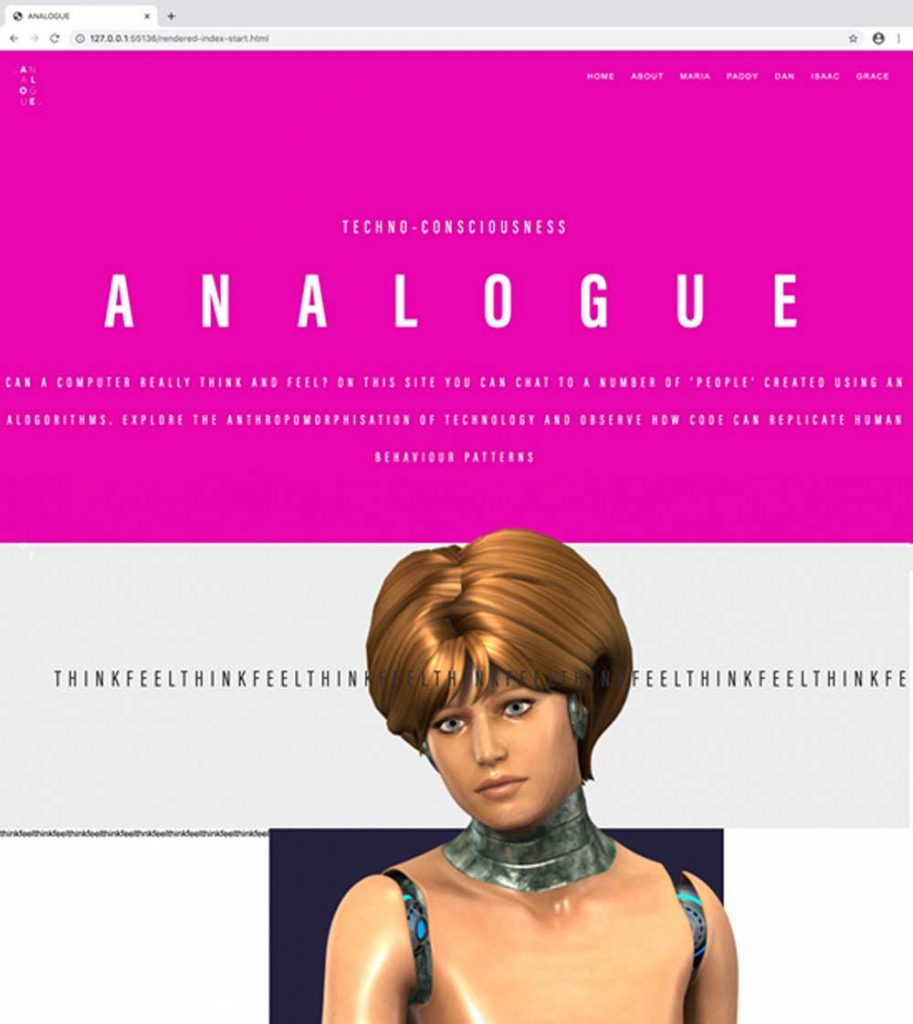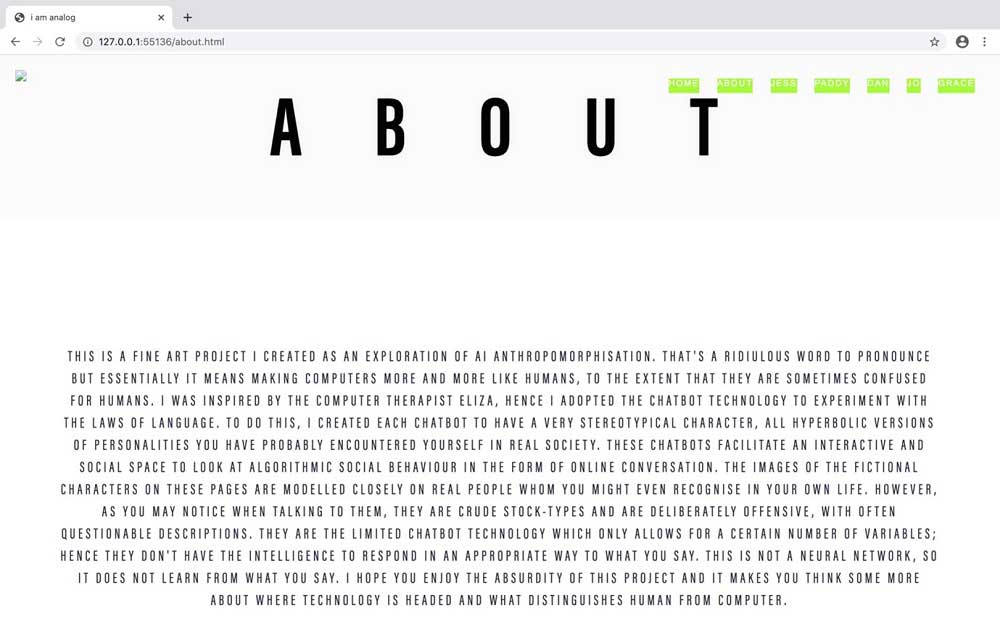CODED CONSCIOUSNESS: TURNING A.I. INTO ART
By Anna-Rose Wain
What comes to mind when you think of artificial intelligence? Perhaps Arnold Schwarzenegger wearing his 80s style sunglasses with the collar of his leather jacket up. Or maybe even a robo-dog with cameras in its eyes doing back flips. Terminator and robo-dogs do make claims to visions of a dystopian future, however, the world of computer intelligence is actually a lot closer to today’s reality than you think. During the first lockdown, there were days when I wouldn’t interact with anyone but my Amazon Echo – an example of A.I – which really got me thinking not only about my dependency on tech, but the distinction between human and computer. Consciousness is regarded as the crux of this discussion, being viewed as the ineffable differentiation between sapiens and bot. As all of my interactions became mediated through Zoom, Facebook Messenger and Netflix Party, it raised the question as to how my ‘consciousness’ or even identity was being translated into data. Was it possible that an algorithm could replicate human identity? Without access to my usual ceramic materials, I found myself fascinated by so-called net.art, especially Shu Lea Cheang’s Brandon(1998) and www.rtmark.com(1998). This is the process I began my experimentation with last semester and has even carried out into my visual enquiries in my final year of studying Fine Art here at Loughborough University.

I-am-analogue.com is a piece of internet art, I coded using HTML and CSS, which allows the viewer to ‘talk’ to a series of ‘people’ created using chatbot technology. Unfortunately, it’s been taken down as it was too expensive for me to keep up but I wanted to share my ideas with you. The concept came from some research I did on the Turing test – a test of a machine’s ability to exhibit intelligent behaviour indistinguishable to a human. Following this, I became interested in attempting to replicate human emotion and communication in a series of chatbots, therefore creating the illusion that these were real, conscious beings. This was when I came across ELIZA; a computer-based algorithm designed by Joseph Weizenbaum in 1966 to stand in as a Rogerian psychotherapist. ‘She’ was the first programme to appear to have passed the Turing Test as ‘clients’ reported that it felt as if they were talking to a human therapist through an online interface instead of a computer. Trying it myself, it became clear that the programme was very inept and shows how early Natural Language Processing (NLP) worked. However, creating my own chatbot would accentuate the same critique of intimacy in the online world.

Programming was something completely new to me, but I knew it was the only way to fully realise my ideas, so I pushed through the YouTube tutorials to create the site. Playing on crude stereotypes, I created brief character profiles to give the visitor an insight into what to expect. Maria, Dan, Paddy, Isaac and Grace are all fictional profiles of individuals who you may recognise from your life; Maria, the driven business intern, Dan, the ‘lads man’ and Paddy, the Irish catholic priest who’s a closeted gay man. Each character profile highlights the brash categorising that A.I performs when recreating human psychology and personality, therefore revealing profiling within contemporary algorithms. Every narrative comes with what appears to be a photographic portrait but is actually a deceptively accurate image lifted from a clever site called thispersondoesnotexist.com which generates artificial faces using GAN (Generative adversarial network) technology (give it a go, it’s really fun and kind of creepy!). I deliberately kept these brief as I wanted the personas to reveal themselves through real-time speech in the ‘Live Chat Boxes’.






Now this is where it gets really interesting (and tricky) – using a software called Robot.me, I programmed each character to respond to certain predicted phrases with set expressions. Here, the artist (me, the human) intervenes in an algorithmic process giving it human based intelligence then letting it run on its own. Naturally, this became complicated quickly! There was no way I could predict every possible human response and I think my friends grew tired of me getting them to talk to my digital creatures. However, I decided to embrace the technologies intervention, allowing for gaps to be filled in by the algorithm. The outcomes were absurd and amusing to say the least. Although the characters were comically realistic at times, it slowly becomes obvious they’re not real. Their artificial nature is revealed through repetition and the more human element shown in the spelling mistakes.

Starting with small talk, the bot occasionally interrupts the flow of natural conversation with a disturbingly personal and sometimes existential proposition such as ‘Does anyone actually care about you?’ or ‘I’ve been watching you through your camera for a while now’. This forced familiarity provides an uncanny perspective of online relationships/friendships in the digital age.
Additionally, I embedded advertisements to create a break in the illusion of intimacy. You don’t have to be a mad conspiracy theorist with a tin foil hat to know that data collection and privacy are hot topics at the moment – this references the deceptive use of artificial intelligence, as has been seen with Siri, Alexa and ‘Hey Google’, to harvest information used for behaviour prediction and therefore advertising. A.I devices such as these may have made our lives infinitely more convenient and seemingly connected but they have also dissolved the privacy and confidentiality of personal information. Through this feature, I wanted to expose corporate ulteriority and show that as A.I becomes increasingly integrated in our lives, we must approach it with caution, aware of its capacity to feed surveillance capitalism.

A serious problem I encountered post-production was translating into a displayable format for a gallery space. The question arose as to whether this was necessary. The crux of the project rested on its online existence as a critique of the communication on the internet. But, if it wasn’t in a gallery did this mean it wasn’t art? When researching the history of net.art it became clear that the early movement defined itself as existing apart from the instutionalised art world, existing in cyberspace where it would be seen by a global audience for free. Yes, I could create QR codes or place a computer monitor in a white cube environment, but wouldn’t this take away from the uncanny intimacy created through viewing net.art on the laptop in your bedroom? I decided that the context of a global pandemic produced the perfect context for this sort of work to thrive, hence, I’ve kept it online alone.

By using chatbot/A.I. technology in a humorous way, I hope it proves that computer learning really does have a place within the contemporary art scene for playful exploration and critique. This project exists to hint at the complexity of consciousness through emotionally engaged conversations, show technologies’ inability to quantify and reproduce human psychology in an algorithm. A.I is a fascinating field of learning which doesn’t just offer post-apocalyptic cyborg visions but real solutions to real problems – we just have to keep drawing the line between a computer serving a human and a human serving a computer.
Hi, my name is Anna-Rose Wain but most people call me Anna. I’m currently in my final year working towards a BFA in Fine Art. My practice is currently centred around New Media, particularly focussing on A.I. from an existential standpoint. Pushing the limits of what ‘art’ is, I use absurd algorithms to replicate human behaviour, identity and psychology in a playful way. These humorous visual experiments with artificial reality invite the viewer into a critique of modern technology through real-time participation. A major part of my creative process is reading lots which is why I enjoy writing so much! You can check out my work by following my Instagram page at “anna_rosew_art” and even have a cheeky read of my blog at https://what-do-you-think.blog/.
The Limit
The Limit showcases the creativity that exists within the student population, creating a sense of community.

